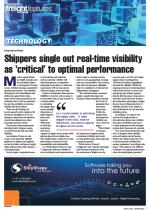Despite having certain standards in place, the freight sector remains paper-driven, local, specific and idiosyncratic. Converting its interactions into data and standards that can feed the needs of Industry 4.0 (4IR) is critical, says Kai Timmermann, chief operating officer at Prompt Global Corporation.“This is also taking place against a backdrop of labour, capacity and assets in general being in short supply, and in demand – and against shifting trade f lows.”Timmermann sees huge opportunities for technology in the freight and logistics sector driven by resource constraints (doing more with less) and significant return on investment (ROI) narratives.“We are also seeing so-called green shoots associated with port authorities, who are starting to pick up the more advanced technologies and leap-frogging the port/terminal-related systems in the United States, Europe and other traditional players,” he tells Freight News. “Also, digital-only participants have entered specific areas of logistics – think of digital freight forwarders – and there is a definite need now to kit incumbents with the tools to out-compete the digital-only players.”Prompt Global Corporation has been working on a hybrid model using user-controls and artificial intelligence (AI) to pull data efficiently and accurately from a variety of logistics paperwork. It extends from basic data capture and integration into the system to robotic process automation (RPA). The company is developing a supply chain grammar framework to improve the speed of integrations and data visibility for partners and internal constituents. It is also developing a simplified business intelligence framework, creating pre-joined or context-oriented tables accessible through Microsoft Office level tools. He says the freight industry’s biggest challenge is still its dependence on paper-based processes. “Another challenge is B2B specificity. Our mental models are often couched in B2C terms, where the user interaction, semantics, etc. are housed within a single platform. Once you get into the B2B world, you are dealing with different entities that have their own enterprise resource planning (ERP), their processes, their own reference numbers, etc. “So, even if you have standards that can be a good structural basis, you need to factor in the B2B company-specific semantics.”Also challenging for the logistics sector is the organisational side and the sharing of information and data. “In the case of a port interaction, there are potentially 10 players involved. These include the carrier (container owner), terminal owner, terminal operator, terminal labour, beneficial cargo owner, chassis owner, destination facility, drayage driver, governmental customs authority, and the NVO forwarder/broker. Aligning their interests so that the relevant information is shared throughout isn’t easy technically, and the participants are not incentivised to provide the information to one another,” explains Timmermann.Technology brings huge opportunities to improve efficiency and accuracy throughout the various processes, saving on time, reducing attention to labour and increasing investment, he says.In-cab cameras and technology that measures harsh braking, cornering and other safety-related issues are making real contributions to safety standards.“Kai Timmermann

